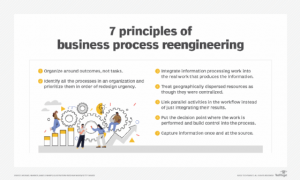Business Process Reengineering (BPR) has been in the news lately, primarily because of its huge success in the banking industry. However, using BPR to change your company’s core processes is a big decision that requires careful thought. In this article, we’ll explore how BPR can benefit an organization and how you can decide whether or not it is right for your business.
What is Business Process Reengineering?
Business process reengineering (BPR) is a type of process improvement that helps businesses improve the way they work by restructuring their processes. It can be used to reduce the time it takes to do things, improve communication and collaboration among team members, and make sure tasks are completed in an efficient and organized way. BPR can be used in any organization, from small businesses to multinational corporations.
There are a number of benefits to using BPR, including:
Reducing the time it takes to do things
Improving communication and collaboration among team members
Making sure tasks are completed in an efficient and organized way
How Business Process Reengineering Differs From IT Automation
When it comes to business process reengineering, there are a few key distinctions that need to be made in order to understand how it differs from IT automation. First and foremost, business process reengineering is focused on optimizing the flow of work within an organization, while IT automation is geared towards improving the efficiency of IT systems. Second, whereas IT automation may be used to improve overall system performance, business process reengineering is typically used to improve the customer experience or operational efficiency. Finally, IT automation can be used to supplement or replace human workers in certain roles, while business process reengineering is typically used in conjunction with human workers.
The Benefits of Business Process Reengineering for Companies
Business process reengineering (BPR) is a process that can help improve the efficiency and effectiveness of business processes. There are many benefits to be gained from BPR, including increased customer satisfaction, reduced costs, and improved communication between departments. Here are some of the most common benefits of BPR:
- Increased customer satisfaction
When businesses address inefficient business processes, customers can benefit in two ways. First, they may experience faster service or fewer delays in getting their orders processed. Second, customers may feel more confident about submitting their orders online because they know the process will be handled properly. Overall, customer satisfaction levels tend to go up when businesses make improvements to their processes.
- Reduced costs
One of the main benefits of BPR is that it can lead to reductions in costs related to business operations. This includes everything from staff time spent on redundant tasks to office space used for storage instead of working space. By streamlining business processes, businesses can reduce their overall costs while also improving their efficiency and communication abilities.
- Improved communication between departments
Another common benefit of BPR is that it can improve the flow of information between different parts of a company. This is important because
Organization Challenges in Implementing Business Process Reengineering
Business process reengineering is a process that can be used in organizations to change how work is done. It can help improve efficiency, communication, and collaboration. However, there are some challenges that businesses should consider before implementing this type of change.
Here are five of those challenges:
- Lack of leadership commitment. Business process reengineering can require significant changes from top management. If top management isn’t committed to the project, it can be difficult to get others on board as well.
- Resistance from employees. Employees may resist changes that affect their jobs or how they’re paid. They may also feel threatened by the unfamiliarity of the new process.
- Limited resources. Business process reengineering can be time-consuming and expensive to implement. If not done correctly, it could damage company productivity instead of improving it.
- Changing business processes can have a negative impact on company data integrity and performance measures. Errors may occur when data is changed or updated as a result of the process changes, which can lead to decreased efficiency and revenue loss.
- Difficulties in communicating the benefits of business process reengineering to employees and customers. Many people don’t
Conclusion
At the heart of any successful business is a process that efficiently delivers value to customers. However, over time this process can become overloaded and bogged down by bureaucracy, red tape, and inflexible systems. At this point, it might be time for your business to consider business process reengineering (BPR).
BPR is a proven methodology that can help your company restore sanity to its processes and enable it to rapidly improve customer experience, productivity, and profitability. If you’re ready to make some serious changes in order to take your business up a level or two, BPR is definitely the right solution for you.






